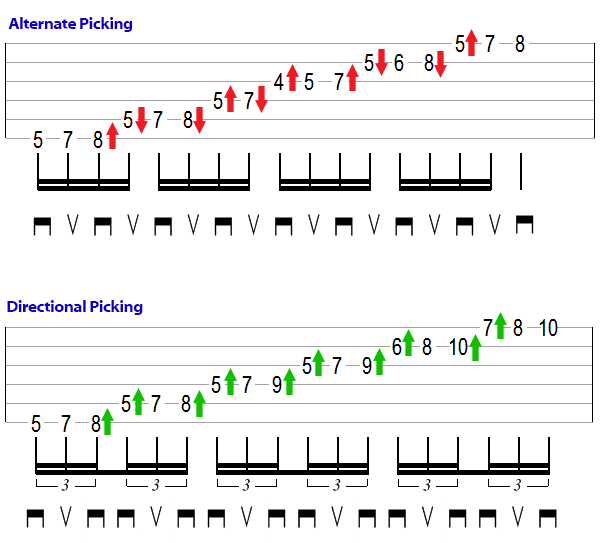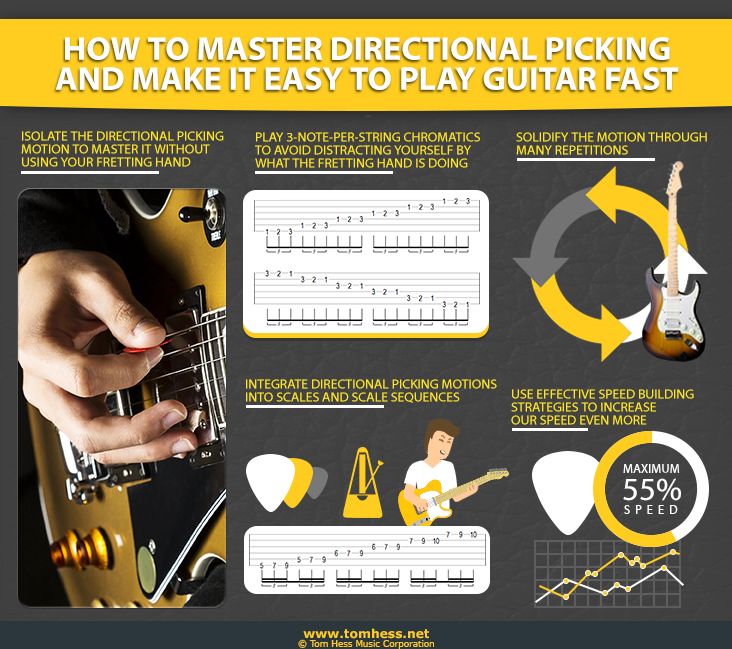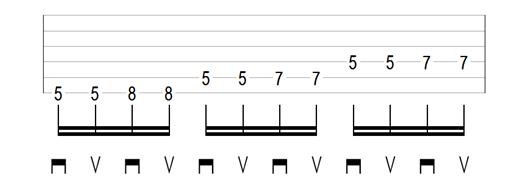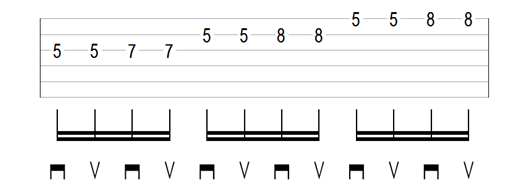How To Improve Guitar Technique To Play Faster And Cleaner
If your guitar playing lacks accuracy, I betcha a dollar to a donut that your problem is:
… lack of 2-hand synchronization!
Yep.
I challenge you to improve your 2-hand synchronization and not get a massive boost in accuracy (and speed) at the same time.
Conversely:
Until you master the skill of getting your hands in sync…
Improving your guitar playing will be as hard as stuffing spilled toothpaste back in the tube.
Watch the video below and I'll show you exactly how to get your hands in tighter sync, so you can start improving your guitar technique right away.
Click on the video to begin watching it.
See my other instructional guitar videos, available to my YouTube subscribers - follow my channel by clicking the button below:
Here are some more tips on mastering 2-hand synchronization and playing guitar faster and cleaner:
2-Hand Synchronization Tip #1: Use Directional Picking.
What is directional picking?
It means you do alternate picking when you are on the same string…
… and always pick in the direction of the string change. Meaning: when you are ascending (in pitch), you change strings with a downstroke.
When you are descending (in pitch), you change strings with an upstroke.
The result?
When you play an odd number of notes per string, you get to use sweep picking to change strings…
… making your playing 33% more efficient than pure alternate picking.
Question: “Tom Hess, what does this efficiency have to do with keeping my hands in sync for guitar?”
Answer: Everything. The less your hands have to move, the less likely your hands are to make mistakes, create sloppy string noise, hit the wrong string and yes – get out of sync..
Look at this example:

Notice, when you use Directional Picking, your guitar pick travels a much shorter distance. (That means playing guitar fast becomes much easier for you).
Your pick stays inside the string trench (the space in between strings) and remains in perfect position to play the next string.
This eliminates the need to stop the pick, turn it around and jump over the string you just played, before you can play the next note.
(All of which happens with alternate picking.)
Question: “But Tom Hess, if directional picking is superior, why do so many guitar players play fast using strict alternate picking?”
Answer: Playing fast with alternate picking is the guitar playing equivalent of sprinting with a weighted vest or digging a swimming pool with a tea spoon.
It can be done – it just requires you to work much harder than you have to.
(Ok, alternate picking isn't quite as extreme as these examples, but you get the idea.)
Point is: someone playing fast with alternate picking isn’t an argument in favor of (or against) the technique. All it proves is that someone was persistent enough with an inefficient technique to master it. (good for them.)
Alternate picking existed before directional picking was invented. That is a big reason why most shredders from the 80s, 90s and early 2000s still use it.
But I'm trying to help guitar players who are looking for an easier path to their goals. Guitarists who are about faster results – not about blindly following tradition.
If that’s you – directional picking is the technique for you :)
Question: “But Tom Hess, isn’t strict alternate picking better for timing?”
Answer: How so exactly? How is it any “better for timing” than say, strict down picking? Or Legato?
If you can’t play in time using directional picking, “going back to alternate picking” isn’t the answer. Improving your timing is :)

Question: “But Tom Hess, doesn't directional picking force you to plan out picking patterns before playing them?”
Answer: Not at all. What you are thinking of is called economy picking. With economy picking, the rule is: you have to sweep pick on every string change.
So, if you want to use economy picking in all of your playing, you do have to plan out your picking patterns.
Directional picking doesn't have this limitation. You alternate pick on the same string and change strings in the direction of the next string. That’s it.
2-Hand Synchronization Tip #2. Practice Guitar Unplugged
Spend some of your guitar practice time playing without your amplifier. And pick the notes loudly enough to be heard acoustically.
How does this help your 2-hand synchronization?
Articulation inconsistency is a common cause of sloppy 2-hand synchronization.
When you play unplugged, you expose inconsistencies in your pick attack.
These inconsistencies are some of the reasons your hands may get out of sync.
Pay attention to the notes where your hands aren’t in sync and make those notes louder. This forces your hands to get in tighter sync.
Note: pay particular attention to articulation of your upstrokes. Articulation of upstrokes is usually much weaker than downstrokes (for most guitar players).
This is particularly common for guitarists who play everything with strict alternate picking.
As a bonus: improving your picking articulation also increases your speed.
That’s because when you practice unplugged, you build more power and stamina in your picking hand.
And when you turn distortion on – you use a lot less of your potential power.
The result?
You can pick much faster and cleaner with less effort… and yes… with better 2-hand synchronization.
Question: “Tom Hess, how much time should I spend practicing guitar unplugged?”
Answer: 5-10 minutes is a good amount to start. You can do this during your warm up time to prepare your hand(s) for playing.
It won't take long for your unplugged practice to make a noticeable difference in your playing.
2-Hand Synchronization Tip #3. Dig the pick deeper into the strings.
This helps you to articulate the notes harder without hitting the strings with more force.
All you do is push the pick a little bit deeper into the string trench (space between strings). This automatically makes the notes louder.
As a side benefit – this articulation boost makes your 2-hand synchronization tighter as well.
2-Hand Synchronization Tip #4. Practice Double Picking
Practice all your scales and scale sequences by picking every note two times.
Check out this example:


Picking every note 2 times makes your 2-hand synchronization more difficult.
Your picking hand is forced to move twice as fast as the fretting hand.
This makes it hard to articulate every note clearly and makes any mistake more obvious.
When you go back to normal playing, your picking feels much easier and your 2-hand synchronization becomes much tighter.
You can apply this strategy in 2 ways:
- Replace your normal guitar warm up routine with double picking training. Play through your guitar technique exercises using double picking for 10-15 minutes. After the warm up time is done, go back to playing guitar as normal.
- Schedule specific time to apply this strategy in your guitar practice schedule. Select specific guitar technique exercises and practice them using double picking.
I can do that for you in my Breakthrough Guitar Lessons.
Tell me about your musical goals and guitar playing challenges. And I’ll create a customized lesson plan to get you playing guitar the way you want.
Plus: I’ll track your progress, give you feedback on your guitar playing and hold your hand every step of the way to nearly guarantee your results.
To begin, go to: https://tomhess.net/Guitar
“I had problems with physical playing. I couldn’t hold the pick, I was struggling a lot, there was frustration for like years. I started out looking for a YouTube solution, maybe someone knows how to angle the pick or build up speed and accidentally ran into Tom.”
The video wasn’t about playing, he only had a conversation. I listened up to him. I saw that Tom made a lot of sense in his speech, and I got interested. I went to his site, started looking at what he offered, got very interested, filled out the form, got my first lesson, started building up myself and started getting more results than I was getting before when I was self taught. It was an amazing experience that opened up so many doors, and still there are so many doors to open.
The material is specifically done for your individual needs, to reach your goals. You can always put up new goals. You can have feedback on your playing, see your weak areas and strong areas. Tom cares a lot about his students. He always reviews and watches how I am progressing so we can review material, step by step. Not skipping the steps. He is paying attention to it, and that’s what I like about it. I last felt this kind of motivation when I was 13 and starting out with a band, now I’m feeling the same fire and passion. There are students who are more advanced, more knowledgeable and have more experience. Instead of feeling jealous, I feel much more motivated to push myself further.Freddy Kuiva, Estonia
“Before I started taking lessons with Tom, I was doing things on my own and it was quite frustrating. I thought I was doing things correctly, but once I started lessons with Tom, I was able to see what I was doing wrong and quickly applied that and got results instantly, within a couple of weeks ... your playing just improves so quickly!”
I've become a hundred of times better guitar player since I've been working with Tom. Most private guitar teachers are somewhat unprepared and kind of work on just whatever, which is ok, but it isn't really as effective as the way Tom does it in terms of how much material he gives you, what material he gives you, and the long term goal of what you want to do. Tom has all that in mind. Tom is very good at giving you what you need to reach your goals.
Mark Court, Professional Musician,
Ontario, Canada
“I found Tom Hess on the net through articles, and I read quite a few of those before I went to Tom’s website. Even though I’m not a metal player at all, and Tom is obviously a metal player, I could still see that his ideas and way of teaching could really benefit me. So I pretty much signed up for online guitar lessons with Tom straight away once I’d gone through the website, and it’s just been a real eye opener with the way he teaches…”
... the integration of concepts that he’ll give you and having a really structured strategy… not just week to week lessons, but things that - you can see from one lesson to the next - really develop and continue to work on your technique and your theory and aural skills and those types of things. So I’d played a long time… 20 years before I really caught onto Tom, and I’d had a lot of lessons, and I’d taught and played but I can really see improvements in my technique, sweeping, and picking which weren’t strong parts of my playing.
I feel like Tom has a good gauge of where you’re at as a guitar player and what you need, and there just seemed to be so much more stuff in the lessons week to week than what you’d ever get in an hour or so in a one on one lesson… way more. So yeah I think that and the forum. I think, I’d pay the money just for the forum. That alone would be fine… I wouldn’t have a problem with that at all. So that alone is massive!
The price for the lessons, that’s nothing... nothing. You know, I think it’s, pretty cheap to be honest. I don’t mean that in a bad way, cheap. Cheap is not a good word, but I just think it’s great value… awesome value. I mean, you know, you could pay that for one-to-one lessons and you just don’t get the same results and support of the forum and the content and the strategies.
Other teachers I’ve had have been good players, and some have become good friends too. But when I’ve started lessons with Tom I’ve got something to compare that to and a lot of it is just sort of teaching songs from week to week… a lot of the lesson will be left up to you… you’ll go to your lesson and they’ll be like what do you want to do today? At the time I said, oh do this song or that song, but with Tom you start to realize that you know, there’s more to it… the goals and you know he’s sort of more in contact with what you want to be able to do as a player, because he’s asking you the questions and then setting up the strategies, so I find that really good.
Yeah I can see more results in 18 months in a lot of areas in my playing than you know 20 years. So it’s sort of, you know, would’ve been great 20 years ago to have met Tom.
Simon Candy, Melbourne, Australia


